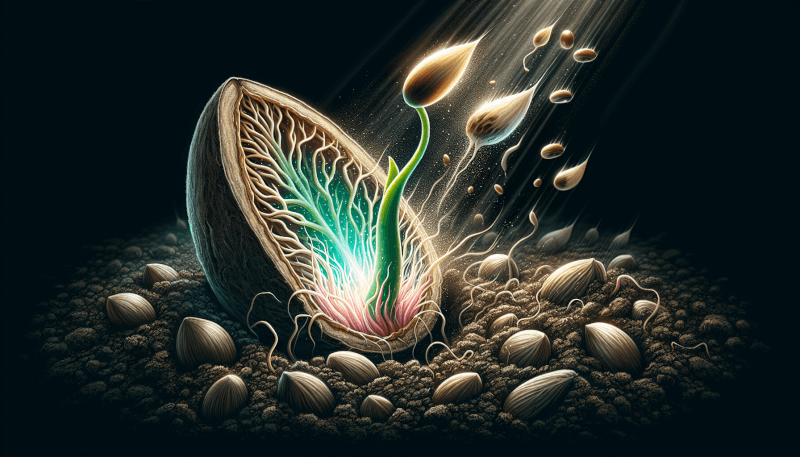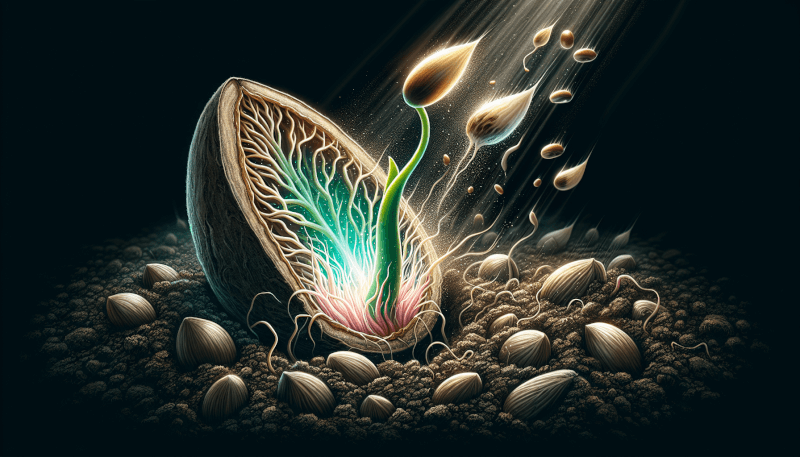Imagine holding a tiny seed in the palm of your hand. It may seem insignificant, but within its minuscule shell lies the potential for new life. Have you ever wondered about the fascinating journey a seed undergoes, from the moment it is nestled into the soil to the magical moment when it sprouts? In this article, we will explore the remarkable process of germination and sprouting, unraveling the mysteries behind nature’s own miracle. Get ready to embark on an awe-inspiring journey as we delve into the captivating world of seeds.
The Journey of a Seed: From Germination to Sprouting

Introduction
Have you ever wondered how a tiny seed can transform into a beautiful plant? The journey of a seed from germination to sprouting is a fascinating process that involves multiple stages and intricate mechanisms. Understanding this journey can deepen our appreciation for the remarkable resilience and potential of nature. In this article, we will explore the stages of a seed’s journey, highlighting the key processes and transformations that occur along the way.
Stage 1: Germination
Germination marks the beginning of a seed’s transformative journey. During this stage, the once dormant seed comes to life and initiates the process of growth. Several crucial events take place during germination that enable the seed to prepare for further development.
Subheading 1: Definition of Germination
Germination is the process by which a seed transforms into a new plant. It involves the reactivation of the seed’s metabolism and the establishment of root and shoot systems. The timing and duration of germination can vary depending on plant species, environmental conditions, and other factors.
Subheading 2: Water Absorption
One of the primary triggers for germination is water absorption. As the seed absorbs water, it activates various enzymes and metabolic processes that were formerly inactive. This influx of water rehydrates the seed’s dry tissues, allowing biochemical reactions to occur.
Subheading 3: Activation of Enzymes
With the aid of water, enzymes present within the seed become active, leading to the breakdown of stored nutrients. These reserves, such as starches and lipids, provide the initial energy and nutrients necessary for the seedling’s growth. The activation of enzymes also triggers the production of important molecules, such as plant hormones, that play pivotal roles in subsequent stages.
Stage 2: Radicle Emergence
After successful germination, the radicle, which is the embryonic root, emerges from the seed. This stage sets the foundation for the development of the root system and establishes a crucial connection between the seedling and the soil.
Subheading 1: Radicle Formation
The radicle forms as a result of cell division and elongation in the embryonic root tissue. Once it emerges from the seed, it starts to grow rapidly, anchoring the seedling into the soil. The radicle’s growth is directed by various plant hormones, which provide signals for proper root positioning and orientation.
Subheading 2: Hormonal Signaling
Hormones, such as auxins, play a crucial role in radicle emergence. They stimulate cell elongation and provide directional guidance for root growth. These hormonal signals ensure that the radicle penetrates into the soil in the correct manner, facilitating the absorption of water and nutrients.
Subheading 3: Root Growth
As the radicle elongates, lateral roots begin to form, branching out from the main root. These lateral roots increase the surface area for nutrient uptake and water absorption. Additionally, the root hairs, which are tiny extensions of the root surface, further enhance the plant’s ability to extract water and minerals from the soil.
Stage 3: Cotyledon Expansion
Cotyledons are embryonic leaves that are present in the seed. In this stage, they undergo expansion and function as a temporary source of energy for the developing seedling.
Subheading 1: Cotyledon Function
The cotyledons, also known as seed leaves, provide essential nutrients and energy to the growing seedling before it can produce its own. They are usually thicker and less complex than the true leaves that will develop later. The cotyledons serve as a vital reservoir of stored nutrients, aiding the seedling’s initial development.
Subheading 2: Photosynthesis Initiation
As the cotyledons expand, they also begin to perform photosynthesis. Photosynthesis is the process by which plants convert light energy into chemical energy, allowing them to produce food and fuel their growth. The cotyledons ensure a sufficient energy supply until the seedling develops its true leaves and can sustain itself through photosynthesis independently.
Subheading 3: Nutrient Mobilization
In addition to providing energy, cotyledons also mobilize essential nutrients stored within them. These nutrients, including proteins, carbohydrates, and minerals, are transported to the growing parts of the seedling, facilitating its development. This process helps ensure a robust and healthy start for the emerging plant.
Stage 4: True Leaf Development
As the seedling continues to grow, it enters the stage of true leaf development. These leaves, unlike the cotyledons, have distinct characteristics and function as the primary organs for photosynthesis.
Subheading 1: Leaf Primordia Formation
The development of true leaves begins with the formation of leaf primordia. Leaf primordia are tiny bumps or folds that emerge from the seedling’s growing tip. They gradually elongate and differentiate into the intricate structures we recognize as leaves.
Subheading 2: Leaf Expansion
Once the leaf primordia have formed, they start expanding, unfurling into their full size and shape. This expansion is driven by cell division and enlargement, allowing the leaf to reach its maximum surface area for light absorption and gas exchange.
Subheading 3: Chlorophyll Production
During leaf expansion, chlorophyll, the pigment responsible for capturing sunlight, is synthesized. Chlorophyll gives leaves their green color and plays a crucial role in photosynthesis. With the production of chlorophyll, the true leaves become capable of converting light energy into chemical energy, further supporting the growth and development of the plant.
Stage 5: Shoot Elongation
In this stage, the focus shifts to the growth and elongation of the shoot system, which consists of stems and branches. Shoot elongation is vital for the plant’s ability to reach sunlight and maximize photosynthesis.
Subheading 1: Stem Growth
Shoot elongation begins with the growth of the stem, which is responsible for supporting the leaves and facilitating the upward movement of the plant. The stem undergoes cell division and elongation, allowing it to extend upwards towards the light source.
Subheading 2: Internode Development
As the stem grows, it develops distinct sections called internodes. Internodes refer to the spaces between leaves or branches along the stem. The length and number of internodes impact the overall height and structure of the plant, ensuring efficient light capture and optimal positioning of leaves.
Subheading 3: Apical Dominance
During shoot elongation, the plant’s growth is regulated by apical dominance. The apical bud, located at the tip of the stem, produces hormones that inhibit the growth of lateral buds. This mechanism directs the plant’s resources towards vertical growth and strengthens the main stem, ensuring the plant’s stability.
Stage 6: Sprouting
The final stage of a seed’s journey is sprouting, where the plant emerges above the ground and becomes visible to the world. Sprouting brings the seed’s transformative journey full circle, with the seedling ready to begin its life as a mature plant.
Subheading 1: Sprout Emergence
Sprout emergence marks the point at which the young plant breaks through the soil surface. It is a critical milestone that symbolizes the successful completion of germination and the beginning of independent growth. The emerging sprout reveals the plant’s stem, leaves, and various other structures that have developed through the previous stages.
Subheading 2: Protection Mechanisms
As the sprout emerges, the plant utilizes various mechanisms to protect itself against potential threats. For instance, thorns, spines, or hairs may develop to deter herbivores. The plant may also release chemical signals to attract beneficial insects or repel pests. These protective adaptations play a vital role in ensuring the plant’s survival and growth.
Subheading 3: Establishment of Growth
Once the sprout has successfully emerged, the plant undergoes further development, including the continuous elongation of stems, the production of new leaves, and the formation of flowers and fruits. These processes enable the plant to mature and reach its full potential, contributing to the biodiversity and beauty of the natural world.
Conclusion
The journey of a seed from germination to sprouting is a captivating tale of resilience, growth, and transformation. From the absorption of water to the emergence of the sprout, each stage is a testament to the complex mechanisms and biological processes that drive a tiny seed towards becoming a flourishing plant. By understanding and appreciating this incredible journey, we can gain a deeper insight into nature’s mastery and the remarkable potential that lies within even the smallest of seeds. So next time you see a seed germinate and sprout, take a moment to marvel at the incredible journey it has embarked upon and the beauty that awaits.




